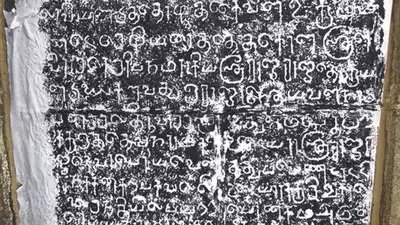
High above the ancient plains of Madurai, nestled atop the rugged Somagiri hills of Melavalavu, history has whispered yet another of its long-buried secrets. Carved into stone, weathered by a thousand monsoons, an inscription has surfaced—one that draws a direct line to one of South India’s most illustrious emperors: Rajaraja Chola I.
This discovery has lit a spark among historians, archaeologists, and lovers of Tamil history. Not just because of the find itself—but because of what it tells us about an empire that once ruled the seas, sculpted stone into poetry, and transformed South India into a cultural powerhouse.
A Hilltop Inscription, A Pan-Regional Empire
The newly unearthed inscription, dated to around 1000 CE, mentions Viranarana Pallavarayan, a military commander under Rajaraja Chola I, and details a temple built by Malaiyappa Sambu. But this is more than a note on a stone—it is a geopolitical marker.
The location of the inscription—in Pandya territory—reinforces what historians long believed but rarely saw spelled out in such direct terms: that Rajaraja Chola’s influence had not only entered but firmly entrenched itself in the Pandya heartland. This was no fleeting conquest. It was a statement: “I am here, and I intend to stay.”
The Rise of a Titan: Rajaraja Chola I
Born to Parantaka Chola II, Rajaraja ascended the throne in 985 CE. But unlike rulers who are born into power, he had to earn it. Rajaraja was recognised early for his strategic mind and leadership, and when the crown did fall upon his head, he wore it with purpose.
And what a reign it was. In less than thirty years, Rajaraja Chola reshaped the map of southern India. He wasn’t merely a king—he was an empire builder.
The Sword and the Sceptre: Conquests and Consolidation
Rajaraja’s military brilliance is legendary. In 988 CE, he struck the Cheras with a crushing victory at Kandalur Salai. Soon after, he stormed the Pandya capital, Madurai, and stamped it with his name—Rajaraja Mandalam, marking the transformation of the region into a Chola province.
By 993 CE, his ambitions crossed the seas. Sri Lanka fell to his forces, with a new provincial capital established in its northern reaches. He didn’t stop there—his campaigns rolled into Karnataka, clashing with the Chalukyas, and expanding the empire deep into the Deccan.
But Rajaraja was more than a warrior. He understood that empires are built not just by the sword, but by the structure.
Rewriting Governance: From Lineage to Loyalty
Breaking from tradition, Rajaraja dismantled the hereditary power structures that had long dominated local governance. He introduced a system of appointed officials—loyal, trained, and accountable.
His empire was split into nine provinces, each allowed a degree of local autonomy. This was no chaotic decentralisation; it was a masterstroke of administrative balance. Villages held assemblies. Local decisions mattered. And yet, everything fed back into the heart of the empire, like tributaries flowing into a mighty river.
Temples as Testimony: The Cultural Pulse of an Empire
Rajaraja’s reign wasn’t just felt in battlefield victories or royal edicts—it was carved in stone, sung in verses, and painted in glorious murals. His magnum opus: the Brihadeshwara Temple in Thanjavur. Towering over the landscape even today, this UNESCO World Heritage site is more than a temple—it’s a statement of identity.
Dravidian architecture found its zenith here. The temple’s shadow never falls on the ground. Its walls whisper stories of Shiva, of kings, of celestial dancers, and of a golden age. Inside, we find murals that could rival Renaissance masters—centuries before the Renaissance even began.
Rajaraja didn’t stop at stone. He minted new coinage, a novel idea in South India at the time. His face appeared beside a seated goddess, a visual blend of divine right and sovereign power.
The Economic Web: Ports, Ships, and Spices
If war built the empire and art adorned it, trade fed it. The Chola economy was a beehive of mercantile activity. Spices, pearls, textiles, and precious stones flowed out of Indian ports toward West Asia and Southeast Asia. In return came gold, horses, and influence.
Mercantile guilds weren’t just business bodies—they were political forces, sometimes more powerful than local kings. They built temples, sponsored art, and even negotiated foreign deals.
So, What Does This Inscription Mean?
In many ways, it’s not just about the text. It’s about the echoes. A thousand years later, a piece of stone from a lonely hill tells us that Rajaraja’s vision was vast, deliberate, and enduring. It shows that his reach extended beyond maps—into culture, architecture, governance, and identity.
The Somagiri inscription is more than an archaeological find. It’s a bridge across time, a moment where the past reaches out and taps us on the shoulder, saying, “Remember me? I shaped your world.”

